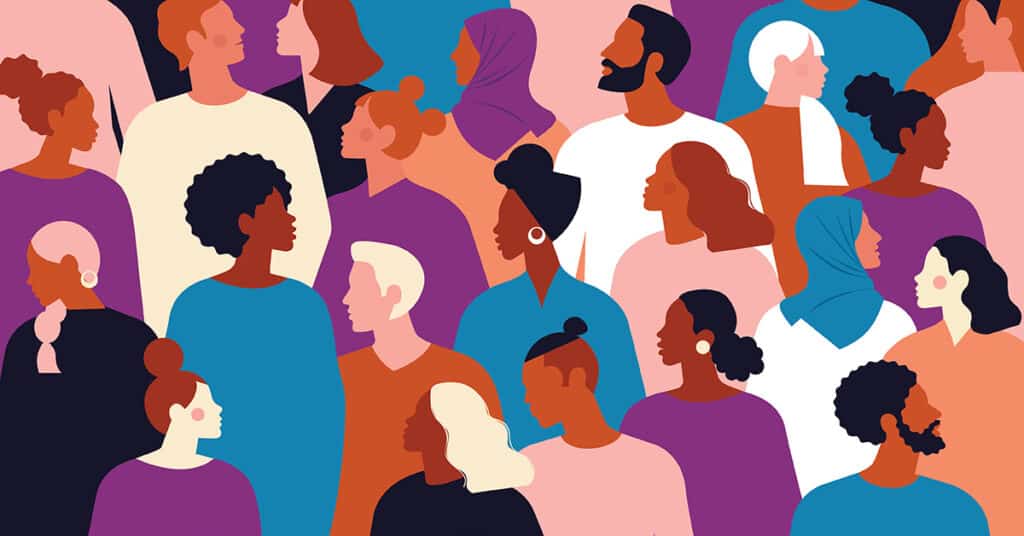Recruiter. Government regulation expert. Employee benefits administrator. Payroll processor. Therapist and confidante. Strategic advisor. HR leaders, if updating your job description in the last few years has felt like you’re piling up a plate at Thanksgiving, you’re not alone.
There’s no question that you and your team deserve a long winter’s nap. But before you do, there’s one more challenge for us all to solve together. Because in our recent conversations with customers here at Jellyvision, one theme has remained present: diversity, equity and inclusion is a top priority as employers look for ways to rectify our country’s long history of discrimination and make way for a more inclusive workforce.
And as we ask how company leaders can better support and create space for a diverse range of employees, there’s one blind spot where we should zone in: health equity.
While it’s clear that the socioeconomic disparities in our healthcare system deserve some much-needed attention, health equity isn’t yet at the forefront of our conversation about DEI in the workplace—and it should be.
Why? Because we still have so much work to do. Among countless statistics, Black Americans face higher mortality rates from heart disease, cancer, and strokes than white Americans. 52% of women say that their weight has been a barrier to receiving appropriate healthcare. And 1 in 4 insurance providers don’t offer coverage for same-sex couples.
In short, making health equity a reality for our people is not only imperative—it’s urgent. That’s why we surveyed HR pros and employees nationwide to find out where there are still inequities when it comes to providing our workforces with the healthcare they need, and what (if anything) companies are doing to address it.
Let’s jump in.
Less than half of HR pros understand health equity
Health equity is quickly emerging as a popular topic under the diversity, equity and inclusion umbrella. From the American Medical Association to Harvard Business Review to NAMI, institutions across the country are sounding the alarm on the imbalances that exist within our healthcare system. And the topic is becoming an increasingly popular search term on Google, too:
Interest in the topic of “Health Equity” in Google Search
August 2022 – October 2022
So it’s encouraging to see that curiosity around this important topic has piqued. But unfortunately, there’s still a gap in education and understanding. Our recent research shows a lot of confusion about what “health equity” actually means, and how it applies to our HR and benefits strategies.
While some HR pros are experts, others are still learning. When asked for a definition of health equity, responses varied widely across the board:
“How would you define health equity? (Give your best guess.)”
Expert
“Giving everyone the opportunity to have access to healthcare”
“Attain your full health potential”
“Health equity is achieved when every person has the opportunity to attain his or her full healthy potential”
“Everyone has fair and just opportunity to attain their highest level of health”
Not-so-expert
“Putting money in an account for medical.”
“I’m not sure”/ “I have no idea”
“The value of your health”
“Prepaid health coverage”
It’s good to see that some of us are ahead of the curve. But these trends show that we could all benefit from more education around this topic. If you’re new to health equity, it’s okay. We’re all learning together, so let’s level-set with a definition from the experts.
What is health equity?
SHRM adds that it’s our responsibility as employers to make that vision a reality, guaranteeing all employees have equal access to healthcare (beyond taking care of basic needs). But are companies taking that responsibility seriously and doing the real work yet, or are they still in the dark? Let’s find out.
HR leaders say health equity is important, but are they making it a reality?
HR pros understand the importance of health equity…
Great job, HR pros: even though our understanding of health equity is still cloudy, we agree that we have a moral imperative to make it a priority. So the good news is that we already have buy-in to make equal access to healthcare a reality for everyone. But let’s dig in a little further: why do HR pros think health equity is so important?
In short, HR pros are telling us that we must do better to provide equal access for equal care so that all employees stay healthy, happy and engaged. As a result, they’ll show up and do their best work—and save everyone thousands of dollars in wasted healthcare spending because they’re getting the right care, at the right time.
…but we haven’t quite achieved it (yet)
Okay. We’re all on the same page about the importance of health equity. But are companies actually putting those words into action to make healthcare access truly equal?
Here’s where things get fuzzy. Our HR respondents are giving themselves a pat on the back for the benefits they provide.
But when asked whether their employer provides them with all the benefits and resources they personally need to stay healthy,
- White employees were 7% more likely than their Black counterparts to say yes
- Cisgender employees were 6% more likely than trans, non-binary and genderqueer employees to say yes
- Heterosexual employees were 7% more likely than LGBTQ employees to say yes
So there are still some discrepancies at play here. Historically overrepresented groups are more likely to feel that their employers are taking care of them, while underrepresented groups aren’t so sure.
And when asked if they believe their organizations offer equal healthcare access to everyone, we continued to see imbalances in employee responses:
Across the board, we’re seeing some disagreements between HR pros and their employees about whether their organization’s benefits packages are truly equitable.
So why is this happening? If every benefit is available to every employee, why aren’t they receiving or interacting with them in the same way? Where’s the disconnect?
One culprit might be in the way we’re educating employees around their benefits. 78% of HR pros said their employees understand the health services available to them. And the general employee population agrees: 76% say the healthcare plan and benefits their employer provides are easy to understand.
But when we look at specific employee groups, the differences continue:
…less likely than the general population to agree that their benefits are easy to understand
And some employees are less sure than others that they know where to find the answers to their benefits questions when they have them:
…less likely than the general population to agree that their benefits are easy to understand
These differences highlight the need for culturally competent benefits education. If we don’t know which benefits are most important to each employee group, and we don’t know how to speak to each group in a way that will resonate most with them, then our messages will be lost. And if we don’t know where to meet our employees where they are, on the platforms where they’re most likely to look for benefits information, then we’re simply ships passing in the night.
In other words, we’re not personalizing our benefits communication—and it’s impacting how our employees learn about, understand and interact with their healthcare plans.
Another culprit? Our lack of understanding about what’s considered “affordable” healthcare to our employees.
Are the benefits your employer provides affordable?
…less likely than the general population to say yes
Of course, there are plenty of reasons why each employee group might respond differently when asked about healthcare costs—pay inequality being one of them. But the many explicit and implicit biases that drive disparities in compensation is another topic entirely, and one that we should cover more completely another day.
For now, here’s the big takeaway for us as HR professionals: once again, it all comes down to personalization. If we don’t have a full understanding of the benefits each employee demographic uses most frequently, or where they’re spending most of their healthcare dollars, then we can’t guide them towards smarter benefits decisions and actions that will help them save more.
And that lack of knowledge, while unintentional, is a huge contributing factor to the inequities we see in our employees’ experiences with healthcare today.
Employers have only touched the tip of the health equity iceberg
We’re getting somewhere
It makes sense that there are still some disconnects when it comes to health equity—because as you saw earlier, we’re still trying to define what it even is.
And if we can’t define it, we can’t implement strategies to fix it. HR pros told us that their organizations are only starting to think about health equity, if at all:
Yes, it’s discouraging that we’ve been so slow to recognize this problem and rectify it. And it’s disappointing that some organizations are continuing to ignore health equity completely. But we’re slowly starting to see the tables turn, and HR pros are finally scratching the surface on more equitable healthcare offerings at their organizations.
When asked why their companies have started to prioritize health equity, HR pros’ top three reasons were improving their employees’ health, job satisfaction, and willingness to join or stay with their organization.
HR Pros: What factors led your organization to address health equity?
- Desire to improve the overall health of employees
- Boost employee satisfaction
- Boost employee retention and attraction
So we’re still in the toddler phases of understanding this important problem, and figuring out how we can finally achieve health equity in the workplace. But the good news is that we’re starting to prioritize health equity for the right reasons: our employees. We’re putting them and their needs first, and we’re looking for ways to make our workplaces more accessible and equitable to a broader range of employees.
What health equity practices have employers already adopted?
Let’s get to the good stuff. Where have we already started to make some progress when it comes to implementing health equity best practices?
HR Pros: Which practices has your organization adopted to promote health equity in the workplace?
HR pros are ready to double down on their efforts to make healthcare equitable
At the top of the list, we’re seeing strides towards more comprehensive healthcare coverage, and employers are following national trends to provide more pay transparency and competitive compensation—two factors that will have an immediate impact on improving healthcare disparities within our organizations.
Where could we still use some work? Auditing our company communications and training programs to ensure we’re using inclusive language, mentoring our employees in a culturally competent way, and choosing vendors that have been historically underrepresented.
While it’s encouraging to see companies start to gravitate towards health equity for all, it’s time to get serious. The truth is, we still have a lot of work to do, and we don’t have any time to waste.
So as we look to the future, where should HR leaders focus their efforts to make health equity a reality at their organizations? Here’s where to start.
Set an intention
First on our list? Make a decision as a team (and an organization) that you’re going to prioritize health equity this year. If you don’t have an intention to solve the problem, you won’t solve it.
Thankfully, our heads are already in the right place:
So the vast majority of HR pros agree that the time is now. The day is here for us to make health equity a priority. Is your organization ready to join them?
Educate your own team first
When asked what role human resources and benefits professionals play in advancing health equity in the workplace, respondents called out education as a big theme:
But you can’t educate employees on the resources they need if you’re not up to speed yourself. So as you begin to have discussions around health equity, make sure you’re taking the time to train yourself and your team—both on a micro and macro level. Can you and your colleagues answer these questions?
- What is health equity as a concept? What’s happening in the national conversation around this topic? What are the most important trends and stats to know? (Great job — you’re already off on the right foot by reading this report!)
- Where are there inequities within your own organization? Which employees aren’t using your benefits package to its full potential? Who feels like they need more information about their benefits? Which employees don’t feel fully supported when it comes to healthcare?
Once you’re an expert, you can more effectively implement health equity best practices at your organization and reach the employees who need you the most.
Seek employee feedback
In that same vein, make sure you’re actually asking your employees how they feel about your healthcare plans, benefits resources and educational materials.
Where are they getting tripped up? Which benefits are most important to them? How would they ideally like to learn about their benefits? You won’t know what they need until you ask them.
It’s also important to identify where there are any gaps in your benefits package itself. Are there any resources that are missing from your existing offerings? Survey respondents told us they’d be most interested in better pay, mental health resources, dental coverage and more affordable care.
And even though HR pros have indicated that they’ve started to make a lot of these changes at their organization, it’s important to stay tuned in with your employees to determine whether your efforts are actually making an impact.
Earn executive buy-in
Even if your entire human resources function is committed to improving health equity at your organization, you simply can’t accomplish your goals in a vacuum. And HR pros agree:
Solving health equity might start with you and your department, by reviewing benefits packages, surveying employees, and analyzing data to see where there are gaps in equity. But you won’t get anywhere if you don’t have buy-in from the top down.
So after you’ve done your research and set an intention to make health equity a priority, build a strong business case to make sure your C-suite is on board, too.
Come prepared with all the hard facts: data on where there are imbalances in healthcare use and understanding in your organization, measurable action items for how you’ll address these problems, and what kind of budget you’ll need to make it happen.
Develop (and write down) your goals
Congrats! You got the green light from your C-suite and your health equity plans are a go. Now what?
Before you jump in, be sure to identify and write down quantifiable goals to help you steer your strategy and understand how successful you were when all is said and done. Because our research shows we still have some work to do here:
That’s great! But it also means there are still 2 in 5 employers who haven’t discussed or recorded any health equity goals, so don’t miss this important step.
Hire an expert (if you can)
As we’ve seen in this report, we all have a hand to play in making our healthcare offerings more equitable. But not many of us are experts at this point, and we don’t have much time to become one. Adding more to your plate simply isn’t going to be efficient, especially for something as important as this.
So when it comes to building and implementing a health equity strategy, turn to a real expert if you can. There are professionals out there whose sole job is to advance diversity, equity and inclusion in the workplace, and they already have a wealth of knowledge about best practices, culturally competent communication, and more. If we want the job done right, we should be relying on these pros for their expertise instead of trying to figure it out ourselves.
So if you have budget, think about hiring a dedicated DEI/health equity manager. Some of you already have a leg up:
But even if you already have a DEI manager in place, there’s always room for improvement, as our employee survey respondents revealed:
So make sure that if you have an expert in-house, they’re highly visible and available to your workforce. Employees should know that you’re working towards improving any gaps in healthcare access at your organization, and that there’s someone responsible for driving those goals forward.
Let’s advance health equity together
As employers, we insure half of the people in this country. That’s right, half.
So as much as we’re still defining and educating ourselves on health equity, we can’t wait any longer. It’s time to correct the centuries of healthcare discrimination and disparities that have existed for far too long.
Not only will it help us stand out as leading employers, but it’s simply the right thing to do. Our employees’ livelihoods depend on it.
So let’s double down. Let’s find new ways to get the right benefits and resources to the right employees at the right time. Let’s educate ourselves, partnering to make sure our workforces have adequate access to healthcare, when and how they need it. We don’t have to be experts, and we don’t have to be perfect, but we do have to start sometime. And that time is now.
Methodology
This survey was conducted in October 2022 by SurveyMonkey on behalf of Jellyvision. It surveyed 500 U.S. adults (ages 18+) who are employed full-time and currently receive their medical insurance through their employer, and 500 HR professionals who are employed full-time.


